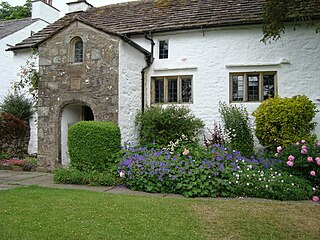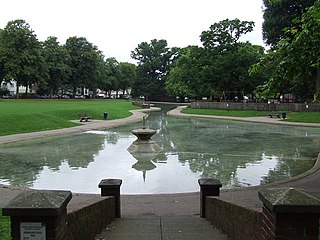
The name Spirella refers to the Spirella Stay which was invented by Marcus Merritt Beeman in the US in 1904 and made from tightly twisted and flattened coils of wire. The founders were Beeman, William Wallace Kincaid and Jesse Homan Pardee.

Brigflatts Meeting House or Briggflatts Meeting House is a Friends Meeting House of the Religious Society of Friends (Quakers), near Sedbergh, Cumbria, in north-western England. Built in 1675, it is the second oldest Friends Meeting House in England. It has been listed Grade I on the National Heritage List for England since March 1954. It is the subject of a twelve-line poem titled "At Briggflatts meetinghouse" by British modernist poet Basil Bunting. Bunting's poem was written in 1975 for the 300th anniversary of the meeting house's construction.

A Friends meeting house is a meeting house of the Religious Society of Friends (Quakers), where meeting for worship is usually held.

The Cloisters in Letchworth Garden City, Hertfordshire in the UK was built in 1905 as an open-air school dedicated to Psychology and where students were taught skills from the Arts and Crafts movement. After a period of neglect during World War II The Cloisters became the North Hertfordshire Masonic Centre in 1951.
Hitchin Rural District was a rural district in Hertfordshire, England from 1894 to 1974, covering an area in the north of the county.

The Ifield Friends Meeting House is a Friends meeting house in the Ifield neighbourhood of Crawley, a town and borough in West Sussex, England. Built in 1676 and used continuously since then by the Quaker community for worship, it is one of the oldest purpose-built Friends meeting houses in the world. It is classified by English Heritage as a Grade I listed building, a status given to buildings of "exceptional interest" and national importance. An adjoining 15th-century cottage is listed separately at Grade II*, and a mounting block in front of the buildings also has a separate listing at Grade II. Together, these structures represent three of the 100 listed buildings and structures in Crawley.

The Brighton Friends Meeting House is a Friends meeting house in the centre of Brighton, part of the city of Brighton and Hove in East Sussex, England. The building, which dates from 1805, replaced an earlier meeting house of 1690 what was then a small fishing village on the Sussex coast. Located at the junction of Ship Street and Prince Albert Street in The Lanes, the heart of Brighton's "old town" area, its architectural and historic importance has been recognised by English Heritage's granting of Grade II listed status.

Scott's Grotto in Ware, Hertfordshire, is a Grade I listed building and with six chambers the most extensive shell grotto in the United Kingdom. "It is, although on a small scale, far more complex than Alexander Pope's at Twickenham. Compared with the grotto at Stourhead, on the other hand, it is minute, but that only enhances the enchantment." The surrounding gardens and structures are Grade II* listed.

Letchworth Garden City, commonly known as Letchworth, is a town in the North Hertfordshire district of Hertfordshire, England. It is noted for being the first garden city. The population at the time of the 2011 census was 33,249.

Fanhams Hall is an 18th-century Queen Anne House-style country house in Wareside, Hertfordshire in the south east of England. It is a Grade II* listed building which is now operating as a hotel.

The Church of St Nicholas in Norton in Hertfordshire is the parish church for what was originally the village of Norton but which today has become a suburb of Letchworth Garden City. The present building dates from about 1109 to 1119, with additions in the 15th century including the tower. Before the Reformation it was a stopping point on the pilgrim route to the Abbey of St Albans and the shrine there.

The Friends Institute Buildings are a former Religious Society of Friends (Quaker) meeting house, community facilities, and associated structures, at 220, Moseley Road, Balsall Heath, Birmingham, England. The various parts are now used as an Art therapy centre, and the Moseley Road Community Centre. In September 2014, the buildings were granted Grade II* designation.

Godalming Friends Meeting House is a Friends meeting house in the ancient town of Godalming in the English county of Surrey. One of many Nonconformist places of worship in the town, it dates from 1748 but houses a congregation whose roots go back nearly a century earlier. Decline set in during the 19th century and the meeting house passed out of Quaker use for nearly 60 years, but in 1926 the cause was reactivated and since then an unbroken history of Quaker worship has been maintained. Many improvements were carried out in the 20th century to the simple brick-built meeting house, which is Grade II-listed in view of its architectural and historical importance.

St George's Church is an Anglican church of modern design in the Parish of Norton in Letchworth Garden City in Hertfordshire. Opening in 1964 and arrow-shaped with a 120-foot concrete spire, the congregation are seated in a semi-circle facing the altar. The church building is in the style of the Liturgical Movement following World War II. It was Grade II listed in 2015 for "its striking architectural form, expressed through a diverse range of materials to provide an innovative building of real quality both in composition and detailing."

The Church of St Mary the Virgin is the Church of England parish church of Letchworth in Hertfordshire. A church appears to have been on the site since before the Norman Conquest. The current church was built in the late 12th century and is Grade II listed. It comes under the Diocese of St Albans. The original dedication of the church is unknown; it was rededicated to St Mary during the First World War.

New Barnet Friends Meeting House is a Quaker meeting house in Leicester Road, New Barnet, north London. It was designed by Leonard Brown, who also designed Quaker meeting houses in Peterborough and Colchester and worked on Letchworth Garden City.

Ilkley Town Hall, on Station Road, Ilkley, West Yorkshire, is a Grade II listed municipal building designed by William Bakewell of Leeds. It forms the centre of a small complex of public buildings, which also includes Ilkley Library, and the King's Hall & Winter Garden theatre. The library, Town Hall and King’s Hall opened in 1908 opposite Ilkley railway station; the Winter Garden was added to the west in 1914.

Letchworth Town Hall is a municipal building in Broadway, Letchworth, Hertfordshire, England. The town hall, which was the headquarters of Letchworth Urban District Council, is a Grade II listed building.

Howard Park and Gardens is a public recreation ground in Letchworth, in Hertfordshire, England, laid out when the garden city of Letchworth was created. It is listed Grade II in Historic England's Register of Parks and Gardens.




















